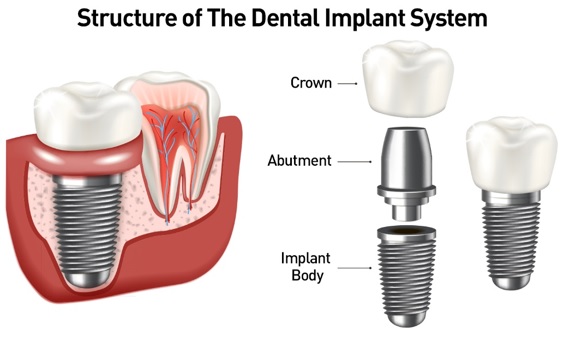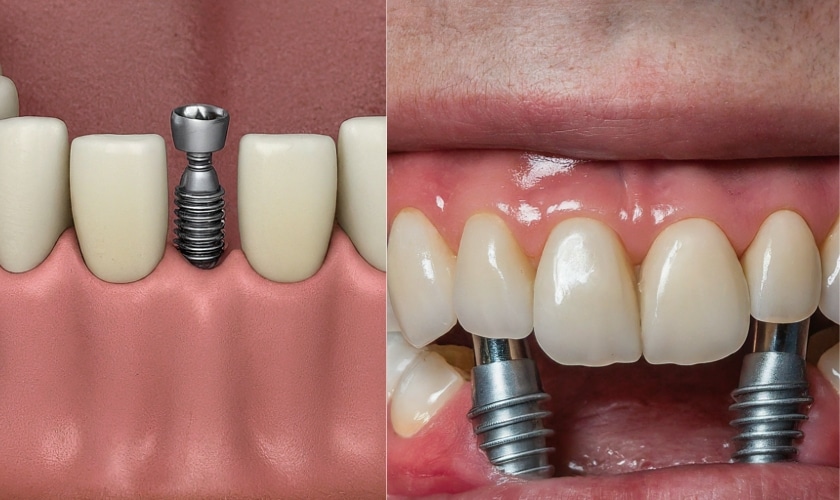Everything about Dental Sense
Everything about Dental Sense
Blog Article
Dental Sense Things To Know Before You Buy
Table of ContentsDental Sense Fundamentals ExplainedThe Dental Sense StatementsAll About Dental Sense10 Easy Facts About Dental Sense Shown
are clinical tools surgically implanted into the jaw to restore a person's capacity to eat or their look. They provide support for man-made (fake) teeth, such as crowns, bridges, or dentures. When a tooth is shed as a result of injury or illness, a person can experience difficulties such as fast bone loss, malfunctioning speech, or changes to chewing patterns that cause pain.Oral implant systems are composed of a dental implant body and oral implant abutment and might likewise include a joint addiction screw. Dental implants. The dental implant body is operatively placed in the jawbone in location of the tooth's origin. The oral implant joint is generally attached to the implant body by the joint addiction screw and extends with gum tissues into the mouth to sustain the attached artificial teeth
(https://moz.com/community/q/user/dentalsense1)Structure of The Oral Implant System selecting oral implants, talk to your dental supplier regarding the possible benefits and dangers, and whether you are a candidate for the treatment. Points to consider: Your total health and wellness is a crucial factor in establishing whether you are a great prospect for dental implants, just how long it will certainly require to recover, and for how long the dental implant may remain in location.
Smoking cigarettes may influence the healing procedure and decrease the lasting success of the implant. The recovery process for the implant body may take a number of months or longer, throughout which time you usually have a temporary abutment instead of the tooth. the dental implant treatment: Very carefully follow the dental hygiene instructions provided to you by your dental provider.
The 20-Second Trick For Dental Sense
Implant failure can cause the need for another surgery to repair or change the dental implant system. Restores the capability to chew Brings back aesthetic look Assists keep the jawbone from reducing due to bone loss Preserves the health and wellness of the bordering bone and gums Assists maintain adjacent (close-by) teeth steady Improves lifestyle Damages to bordering all-natural teeth throughout dental implant placement Injury to the surrounding tissues throughout surgical treatment, such as sinus perforation Injury during surgery (for example, crack of bordering jawbone) Inadequate function, such as seeming like the teeth do not bite with each other typically An experience that the tooth hangs or twisting in location resulting from a joint screw loosening up Implant body failing (looseness of the dental implant body) as a result of systemic infection, which may be Get the facts most likely in patients with uncontrolled diabetics issues because of regional infection in bone and periodontals supporting the dental implant body because of delayed recovery, which might be most likely in clients who smoke Difficulty cleaning the gum tissues around the dental implant, resulting in inadequate oral hygiene Untreated gum condition Post-surgical tingling because of nerve impingement or damage Always alert healthcare providers and imaging specialists that you have dental implants prior to any type of magnetic resonance imaging (MRI) or x-ray treatments.
FDA is not knowledgeable about any type of negative events reported for MRI or x-ray treatments with oral implants. Oral implants systems are typically made of materials that follow worldwide consensus requirements of the International Organization for Standardization (ISO) or ASTM International. These standards have details of what makes a safe material.

An oral implant is a structure that replaces a missing tooth. With screw-like gadgets, the specialist inserts an implant right into the jawbone, and it works as an anchor for an artificial tooth, called a crown. A gadget called an abutment links the artificial tooth to the oral implant. The crown is personalized to fit the individual's mouth and match the color of their teeth.
How Dental Sense can Save You Time, Stress, and Money.
Some people are not qualified for oral implant surgery. It is for oral doctors to operate people with: intense illnessuncontrollable metabolic diseasebone or soft cells condition or infectionIf these problems are fixed, a person can have the surgery. In, oral cosmetic surgeons avoid operating individuals with: If people with any one of the above go through oral implant surgical treatment, there is a greater threat of the implant failing.

Oral implant surgery is a tailored procedure. Provide you time to heal. Affix the blog post and last crown, bridge or denture.
Next off, your surgeon will carefully put the oral implant right into your jaw. If your dental implant is near the front of your mouth, your dentist will make a short-term tooth for you to wear until you heal.
Unknown Facts About Dental Sense
During the recovery stage, your jawbone ought to fuse to the oral implant. This procedure can take anywhere from three to nine months.
When your dental implant heals, your dental professional can affix the abutment (tiny port blog post) and your last reconstruction (crown, bridge or denture). This typically takes about one hour to finish and might need a 2nd small surgery. You shouldn't really feel any type of discomfort throughout your dental implant procedure since your company will certainly use medicine to numb your gums.
Report this page